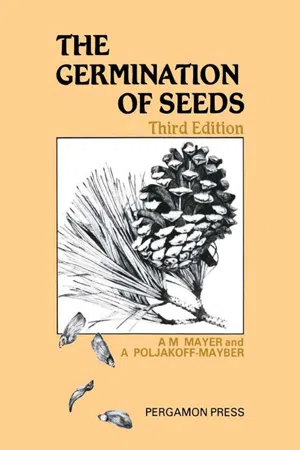![]()
Chapter 1
THE STRUCTURE OF SEEDS AND SEEDLINGS
Publisher Summary
This chapter discusses the germination of seeds and spores of bacteria, fungi and ferns, as well as the processes occurring in the pollen grain when the pollen tube is produced. The seed of angiosperms is essentially simple in structure and develops from a fertilized ovule. It consists of an embryo surrounded by an envelope. The three basic structures—embryo, testa, and endosperm—play a significant role in the seed’s makeup, which by no means is constant. The testa is a structure of considerable importance because it forms the barrier between the embryo and its immediate environment. In some plants, seeds arise by apomixis or nonsexual processes, the seed being formed usually from a diploid nucleus. The size and shape of the seeds is extremely variable. It depends on the form of the ovary, the condition under which the parent plant is growing during the seed formation and the species. Moreover, cell division and cell elongation occur in the germination of seeds when the embryo pierces the seed coat. It occurs when the cells of the seed are activated in some way, so as to permit the control of these processes by various factors. Gamma radiation and low temperatures are used to delay cell division and hypertonic solutions of mannitol to arrest cell elongation.
The term germination is used to refer to a fairly large number of processes, including the germination of seeds, and of spores of bacteria, fungi and ferns as well as the processes occurring in the pollen grain when the pollen tube is produced. Although all these are processes of germination, we will confine the use of the term germination to the seeds of higher plants, the Angiosperms. Extension beyond this would lead to discussions which are well outside the scope of this monograph.
The seed of Angiosperms is essentially simple in structure and develops from a fertilized ovule. It consists of an embryo surrounded by an envelope (the testa or seed coat). The embryo is usually derived from the fusions of nuclei of the male and female gametes, i.e. it is the result of the fertilization of the egg cell in the embryo sac by one of the male nuclei from the pollen tube. The testa originates from the mother plant and normally develops from the integuments of the ovule. In addition Angiosperm seeds contain an endosperm. The endosperm may persist as a storage organ or it may partly or fully degenerate, remaining as a rudimentary tissue particularly in those cases where the cotyledons serve as storage organs. The endosperm may become fused to the seed or fruit coat.
The endosperm is derived, like the embryo, from maternal and paternal genetic material. Its primary nucleus arises from the triple fusion of two of the polar nuclei with one of the sperm nuclei (Fig. 1.1). Frequently the endosperm tissue is triploid, but its ploidy can be very high, and differ in various regions of the endosperm. This polyploidy arises from secondary processes after division of the primary nucleus. The endosperm may remain coenocytic throughout or it may show cellular organization. In some cases the coenocytic endosperm remains completely liquid as in the case of Cocos nucifera (Bhatnagar and Johri, 1972).
Fig. 1.1 Ovule and embryo sac before and after fertilization.
(a)
General appearance of ovule of Plumbago capensis. (1) Embryo sac; (2) Integuments. (b), (c), (d) Embryo sac of Lilium martagon before and after fertilization.
(b) Mature embryo sac.
(c) Discharge of pollen tube into embryo sac (male nuclei), see arrows.
(d) Contact of one male nucleus with egg nucleus and the other with two polar nuclei (after Maheshwari, 1950).
In addition to these three basic structures, embryo, testa and endosperm, other tissues may occasionally participate in the seed’s make-up, which is by no means constant. The testa is sometimes made up of tissues other than the integuments, e.g. the nucellus, the endosperm and sometimes even the chalaza. The testa itself varies greatly in form. It may be soft, gelatinous or hairy, although a hard testa is the form most commonly met.
The testa is a structure of considerable importance because it forms the barrier between the embryo and its immediate environment. One of the more interesting features of the testa of some seeds is its impermeability to water. This has been studied in detail in the genus Pisum (Werker et al., 1979). The testa in these seeds contains a layer of palisade cells which is continuous, whose caps are very hard and impregnated with pectinaceous material. In these cells themselves or in a layer below them, in the osteosclereid cells, quinones are layed down. It is the combination of these two features which renders the seeds impermeable to water. For a recent detailed discussion of seed coat structure and its relation to impermeability see Werker (1980). In the seeds of Pancratium maritimum the testa contains many dead cells as well as air spaces while its outer layer is water impermeable and impregnated with quinones. The air filled testa renders the seeds buoyant and this together with the impermeability of the outer layer to water permits them to float for example in sea water (Werker and Fahn, 1975).
Attached to the testa, developing from other parts of the mother plant, e.g. the funiculus, is the elaiosome. This organ, generally lipid containing, acts as an attractant to insects, e.g. ants (see Chapter 7). Elaiosomes occur for example in Pancratium parviflorum.
In some plants seeds arise by apomixis or nonsexual processes, the seed being formed usually from a diploid nucleus. Cases of polyembryony can arise either due to the division of the zygotic embryo, as in orchids, or due to secondary embryo development from the nucellar tissue, as in some citrus species. Various other aberrations in seed formation are also known.
The size and shape of seeds is extremely variable. It depends on the form of the ovary, the condition under wh...

